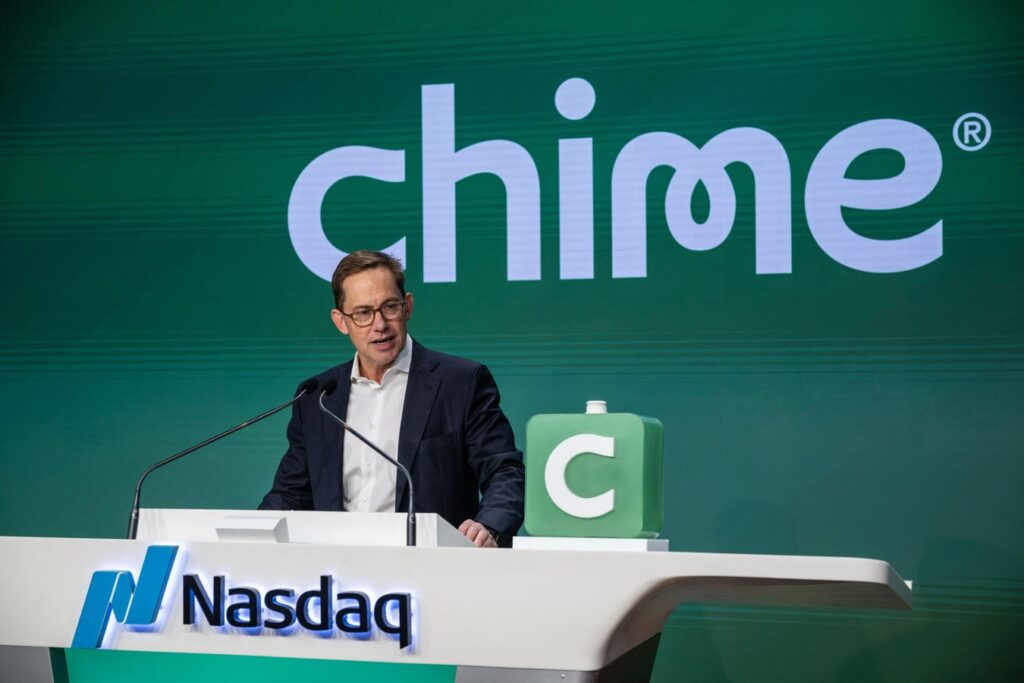Chime CEO Chris Britt on the company’s first day of trading as a public company in June 2025. Its stock rose 37% on its first day of trading.
Bloomberg
In any first earnings call for a public company, the bar is high–investors hope to see a company’s numbers sail past expectations. During San Francisco digital bank Chime’s inaugural call last night, it announced revenue and profit that exceeded Wall Street analysts’ predictions. But this morning, the stock fell by 13% in early trading, dragging down its share price below $30 and its market value to $11 billion. Chime went public on June 12 at $27 per share.
Chime’s second quarter revenue for 2025 was $528 million, up 37% from the year prior. Analysts surveyed by FactSet had expected $503 million on average. Its adjusted earnings before taxes, depreciation and amortization, a common Wall Street profit metric also known as adjusted EBITDA, was $16 million, beating the $4.7 million analysts had expected.
There’s likely some investor disappointment that the company didn’t beat Wall Street’s expectations by an even wider margin. But the bigger issue is future growth. Chime only added 100,000 new active customers from the prior quarter, edging its total monthly active user base up to 8.7 million. Given Chime’s heavy spending on marketing and sales and continued efforts to bring more customers in the door, “We were hoping for a little more upside,” Deutsche Bank analyst Nate Svensson wrote in a research note.
Seasonality always plays a big role in Chime’s second quarter results. Over the past two years, its second quarter growth has been notably slower than that of other quarters, while first quarter expansion has been much faster. That’s because tax refunds tend to be a big boost for Chime’s customers, many of whom are everyday Americans earning about $50,000 a year, CEO Chris Britt has said.
Have a story tip? Contact Jeff Kauflin at jkauflin@forbes.com or on Signal at jeff.273.
Chime’s revenue forecast for the full year of 2025 of $2.14 billion to $2.16 billion may have also underwhelmed investors. That marks growth of about 29% versus 2024, slightly lower than the year-prior pace of 31%. It also implies that Chime’s fourth quarter 2025 revenue will be up about 19%, estimates Piper Sandler analyst Patrick Moley, which is down from 25% fourth quarter growth from 2024.
Additionally, some analysts asked questions about Chime’s “Day One” strategy of trying to bring in more customers by lifting requirements for them to sign up. Historically, Chime has been extremely successful convincing customers to set up direct deposit of their paychecks into their Chime accounts. It has made that a requirement to access features like SpotMe, which gives customers up to $200 in free cash advances.
Today, more than half of Chime’s 8.7 million monthly active customers have direct deposit set up, essentially making Chime their primary bank. That makes them lucrative for Chime, since they use their Chime cards for many of their purchases, and Chime’s primary business model is to make money on interchange, the 1% to 2% fees merchants pay to accept credit and debit cards.
With its Day One approach, Chime is experimenting with loosening those restrictions to get more customers in the door, with the hope of converting them over time. When asked about it, CEO Chris Britt said, “There isn’t going to be a single path to converting people to direct deposit, which is always our number one goal. We know that some people are going to want to date the best before they get married. And so we feel really good about this strategy. And I think you’re seeing it in the numbers.”
The brightest spot in Chime’s earnings was MyPay, a feature that gives customers free paycheck advances of $20 to $500, charging a $2 fee only for instant transfers (otherwise, the advance is free and arrives within 24 hours). Chime launched MyPay about a year ago, and it has already reached $300 million in annualized revenue, the company said. Credit loss rates, or the percentage of the small loans that people don’t pay back, fell from 1.6% in the first quarter of 2025 to 1.4% in the second quarter, a faster decrease than the company had expected. That’s also a much lower default rate than what’s typical for credit cards or buy-now, pay-later loans. The company’s long-term goal is to bring MyPay default rates down to 1%.
One analyst also asked Chime about whether it will be hurt by the new fees that JPMorgan Chase is planning to charge data aggregators like Plaid, which could get passed on to Plaid’s fintech customers. Plaid facilitates connections between bank accounts and fintechs to allow for features like money transfers and balance checks. Britt said the fees won’t affect Chime, because most of its active customers use Chime as their primary bank. So they don’t need to connect to outside bank accounts as often as other major fintechs. “We really don’t see this idea of charging for access as having any sort of negative impact on our side at all,” Britt said.
Read the full article here


